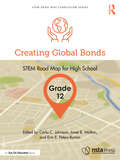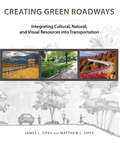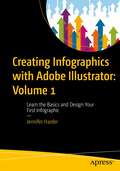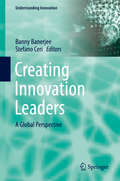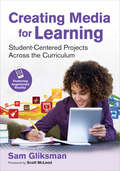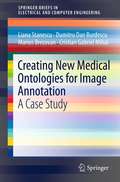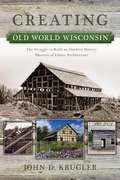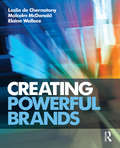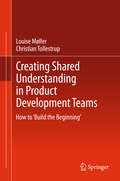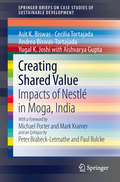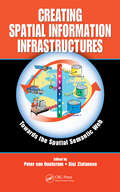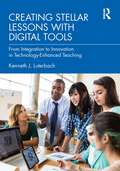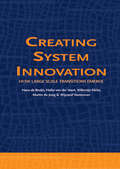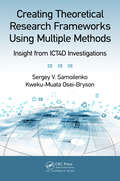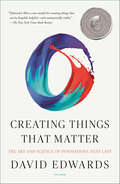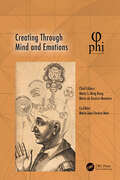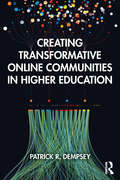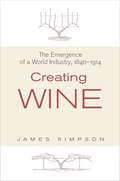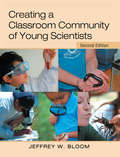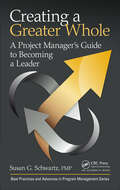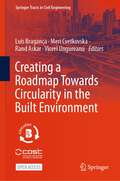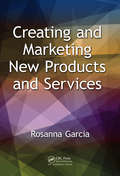- Table View
- List View
Creating Global Bonds, Grade 12: STEM Road Map for High School (STEM Road Map Curriculum Series)
by Janet B. Walton Peters-Burton, Erin E.What if you could challenge your twelfth-grade students to explore energy consumption and climate change in their own communities, and connect that information with other communities around the world? With this volume in the STEM Road Map Curriculum Series, you can! Creating Global Bonds outlines a journey that will steer your students toward authentic problem solving while grounding them in integrated STEM disciplines. Like the other volumes in the series, this book is designed to meet the growing need to infuse real-world learning into K–12 classrooms. This interdisciplinary, three-lesson module uses project- and problem-based learning to help students create an action plan to address issues of energy consumption and climate change, exploring the topic at both local and global levels. Students will gather data on energy consumption and climate change in their communities, partnering with international students to undertake problem-solving activities that examine issues that are both common and unique to each community. To support this goal, students will do the following: · Identify modes and trends in energy consumption in their communities and regions; · Analyze how those patterns of energy consumption impact climate change; · Partner with students internationally to coordinate efforts to synthesize energy consumption data and discern connections across contexts, taking the form of an international blog; · Design and present an action plan to address issues of energy consumption and climate change, ultimately delivering a white paper and interactive web-based presentation on local and international issues of energy consumption and climate change. The STEM Road Map Curriculum Series is anchored in the Next Generation Science Standards, the Common Core State Standards, and the Framework for 21st Century Learning. In-depth and flexible, Creating Global Bonds can be used as a whole unit or in part to meet the needs of districts, schools, and teachers who are charting a course toward an integrated STEM approach.
Creating Green Roadways: Integrating Cultural, Natural, and Visual Resources into Transportation
by James L. Sipes Matthew L. SipesRoads and parking lots in the United States cover more ground than the entire state of Georgia. And while proponents of sustainable transit often focus on getting people off the roads, they will remain at the heart of our transportation systems for the foreseeable future. In Creating Green Roadways, James and Matthew Sipes demonstrate that roads don't have to be the enemy of sustainability: they can be designed to minimally impact the environment while improving quality of life. The authors examine traditional, utilitarian methods of transportation planning that have resulted in a host of negative impacts: from urban sprawl and congestion to loss of community identity and excess air and water pollution. They offer a better approach--one that blends form and function. Creating Green Roadways covers topics including transportation policy, the basics of green road design, including an examination of complete streets, public involvement, road ecology, and the economics of sustainable roads. Case studies from metropolitan, suburban, and rural transportation projects around the country, along with numerous photographs, illustrate what makes a project successful. The need for this information has never been greater, as more than thirty percent of America's major roads are in poor or mediocre condition, more than a quarter of the nation's bridges are structurally deficient or functionally obsolete, and congestion in communities of all sizes has never been worse. Creating Green Roadways offers a practical strategy for rethinking how we design, plan, and maintain our transportation infrastructure.
Creating Infographics with Adobe Illustrator: Learn the Basics and Design Your First Infographic
by Jennifer HarderThis full-color book will teach you how to use Adobe Illustrator's various tools to create infographics, as well as basic page layouts for them. This is the first of three volumes which will cover all the fundamentals of Illustrator, an industry standard application used by graphic designers and marketing and communication teams. How is an infographic different from a logo or any other illustration? What additional thought processes, skills, or software tools should be utilized to create an infographic? In this first volume of Illustrator Basics, you will learn the answers to all these questions. Author Jennifer Harder will walk you through creating basic infographics in Illustrator using Basic Shape tools, Pen Tools, Type Tools, and Symbols. Upon completing this volume, you will have an appreciation for how easy it is to design an infographic and discover how rudimentary shapes and colors can affect readability while conveying meaning to your audience. You will be able to use this knowledge to create your own infographics using Illustrator’s wide array of tools. Who This Book Is For Discover the tools within Illustrator that are ideal for creating basic infographicsDevelop a logo based upon a scanned sketchGain an understanding of different infographic layouts and the process of reviewing them with your client Who This Book Is For Beginner-level designers and others who are interested in learning the process of creating infographics for their company, the classroom, for a visual resume, an article in a magazine, or a webpage.
Creating Innovation Leaders: A Global Perspective (Understanding Innovation)
by Stefano Ceri Banny BanerjeeThis book focuses on the process of creating and educating innovation leaders through specialized programs, which are offered by leading academic schools. Accordingly, the book is divided into two parts. While the first part provides the theoretical foundations of why and how innovation leaders should be created, the second part presents evidence that these foundations can already be found in the programs of ten top-level universities. Part one consists of six chapters following a rigorous plan of content development, addressing topics ranging from (1) innovation, to (2) the settings where innovation occurs, (3) innovation leadership, (4) the need to change education, (5) a taxonomy of advanced educational experiences, and (6) cases of positive vs negative innovation leadership in the context of complex problems. Here the authors show that a new kind of innovation leadership is urgently needed, how it can be created, and how it is put into action. The second part is a collection of invited chapters that describe in detail ten leading academic programs: their objectives, curricular organization, enrollment procedures, and impact on students. Selected programs include four North American institutions (Stanford's d. school, Harvard's Multidisciplinary Engineering Faculty, Philadelphia University, OCAD's Master of Design on Strategic Foresight & Innovation), five European institutions (Alta Scuola Politecnica of Milano and Torino, the EIT Master Program, Paris' d. school, Brighton's Interdisciplinary Design Program, Aalto University) and the Mission D program at Tongji University in China. The book is dedicated to all those who recognize the need to provide stimuli regarding innovation and innovation leadership, primarily but not exclusively in academia. These include, but are not limited to, professors, deans and provosts of academic institutions, managers at private organizations and government policy-makers - in short, anyone who is engaged in promoting innovation within their own organization, and who feels the need to expand the intellectual and practical toolbox they use in this demanding and exciting endeavor.
Creating Media for Learning: Student-Centered Projects Across the Curriculum
by Sam GliksmanHelp Students Show Learning Through Media Creation Education hinges on effective communication. This book demonstrates how media has become a core component of modern communication and highlights the need to incorporate student-centered media projects throughout the curriculum. Self-expression with media will enhance the learning process and allow students to creatively demonstrate their knowledge. The strategies and tactics these pages offer equip educators to make their students enthusiastic experts at producing dynamic media projects. Content includes: The how, why, and when of prompting students to create their own media across subjects and grade levels. Keys to mastery of media formats from simple photography to eBooks to complex animations. Detailed descriptions of student projects that utilize different media. The benefits of media sharing, and how to do it responsibly. The innovative use of Augmented Reality, so readers can activate a video on the book’s printed pages with their mobile devices. Across all disciplines, mastery of media creation is central to the success of current and next generation students. Educators who implement this book’s ideas will be amazed by the resultant increase in student engagement and depth of learning. "What a thoughtful collection of student-created products. This book highlights a variety of multimedia projects, offers a multitude of best practices and practical implementation tips, and is sure to empower teachers to help students find their voice." Lisa Johnson, Eanes ISD Ed Tech @TechChef4u
Creating Media for Learning: Student-Centered Projects Across the Curriculum
by Sam GliksmanHelp Students Show Learning Through Media Creation Education hinges on effective communication. This book demonstrates how media has become a core component of modern communication and highlights the need to incorporate student-centered media projects throughout the curriculum. Self-expression with media will enhance the learning process and allow students to creatively demonstrate their knowledge. The strategies and tactics these pages offer equip educators to make their students enthusiastic experts at producing dynamic media projects. Content includes: The how, why, and when of prompting students to create their own media across subjects and grade levels. Keys to mastery of media formats from simple photography to eBooks to complex animations. Detailed descriptions of student projects that utilize different media. The benefits of media sharing, and how to do it responsibly. The innovative use of Augmented Reality, so readers can activate a video on the book’s printed pages with their mobile devices. Across all disciplines, mastery of media creation is central to the success of current and next generation students. Educators who implement this book’s ideas will be amazed by the resultant increase in student engagement and depth of learning. "What a thoughtful collection of student-created products. This book highlights a variety of multimedia projects, offers a multitude of best practices and practical implementation tips, and is sure to empower teachers to help students find their voice." Lisa Johnson, Eanes ISD Ed Tech @TechChef4u
Creating New Medical Ontologies for Image Annotation: A Case Study (SpringerBriefs in Electrical and Computer Engineering)
by Liana Stanescu Dumitru Dan Burdescu Marius Brezovan Cristian Gabriel MihaiCreating New Medical Ontologies for Image Annotation focuses on the problem of the medical images automatic annotation process, which is solved in an original manner by the authors. All the steps of this process are described in detail with algorithms, experiments and results. The original algorithms proposed by authors are compared with other efficient similar algorithms. In addition, the authors treat the problem of creating ontologies in an automatic way, starting from Medical Subject Headings (MESH). They have presented some efficient and relevant annotation models and also the basics of the annotation model used by the proposed system: Cross Media Relevance Models. Based on a text query the system will retrieve the images that contain objects described by the keywords.
Creating Old World Wisconsin
by John D. KruglerWith its charming heirloom gardens, historic livestock breeds, and faithfully recreated farmsteads and villages that span nearly 600 acres, Old World Wisconsin is the largest outdoor museum of rural life in the United States. But this seemingly time-frozen landscape of rustic outbuildings and rolling wooded hills did not effortlessly spring into existence, as John D. Krugler shows in Creating Old World Wisconsin. As dozens of historic buildings were transported in the 1970s from various locations throughout the state to the Kettle Moraine State Forest, researchers, curators, and volunteers launched a massive preservation initiative to salvage fast-disappearing immigrant and migrant architecture. They created a backdrop against which twenty-first-century interpreters demonstrate nineteenth- and early twentieth-century agricultural techniques and artisanal craftsmanship. The site, created and maintained by the Wisconsin Historical Society, offers visitors a unique opportunity to learn about the states rich and ethnically diverse past through depictions of the everyday lives of its Norwegian, Danish, Finnish, German, Polish, African American, and Yankee inhabitants. Creating Old World Wisconsin chronicles the fascinating and complex origins of this outdoor museum, highlighting the struggles that faced its creators as they worked to achieve their vision. Even as Milwaukee architect and preservationist Richard W. E. Perrin, the Societys staff, and enthusiastic volunteers opened the museum in time for the national bicentennial in 1976, the site was plagued by limited funds, bureaucratic tangles, and problems associated with gaining public support. By documenting the engaging story of the challenges, roadblocks, false starts, and achievements of the sites founders, Krugler brings to life the history of the dedicated corps who collected and preserved Wisconsins diverse social history and heritage.
Creating Powerful Brands: The Strategic Route To Success In Consumer, Industrial And Service Markets (Cim Professional Ser.)
by Leslie de ChernatonyThis has long been the one book that students can rely on to get them thinking critically and strategically about branding. This new fourth edition is no exception. THE definitive introductory textbook for this crucial topic, it is highly illustrated and comes packed with over 50 brand-new, real examples of influential marketing campaigns. Bullets:• Summarises the latest thinking and best practice in the domain of branding• All new real marketing campaigns show how branding theories are implemented in practice• Brought right up to date with a clear European and UK focusUndergraduate business and marketing students studying brand management will find this an invaluable resource in their quest to understand how branding really works.
Creating Shared Understanding in Product Development Teams: How to ‘Build the Beginning’
by Louise Møller Christian TollestrupDevelopment projects that span different disciplines and groups often face problems in establishing a shared understanding of the project's purpose, deliverables, and direction. Creating Shared Understanding in Product Development Teams: How to 'Build the Beginning' uses research-based cases from TC Electronic, The Red Cross, Daimler AG, and Copenhagen Living Lab to demonstrate one approach to this problem complex. It shows how prototyping specific physical artifacts can function as drivers and focal points for creating the much needed shared understanding. Encompassing both the participant's and the facilitator's point of view, Creating Shared Understanding in Product Development Teams: How to 'Build the Beginning' provides both practical examples and theoretical explanation for the process of creating shared understanding. This book provides a toolbox and a practical guide for planning, executing, and facilitating workshops. The result is a clear outline of how to facilitate the creation of physical artifacts that enables and stimulates communication between team members, users, and stakeholders in order to create shared understanding of projects
Creating Shared Value: Impacts of Nestlé in Moga, India (SpringerBriefs on Case Studies of Sustainable Development)
by Asit K. Biswas Cecilia Tortajada Andrea Biswas-Tortajada Yugal K. Joshi Aishvarya GuptaNestlé's Moga factory was set up in 1961 and comprises of the primary milk collection area for Nestlé's operations. Since its inception in Moga, Nestlé has been working with its milk farmers and ancillary suppliers towards improving quality and productivity. The study presented in this book (carried out by the Third World Centre for Water Management, Mexico) highlights Nestlé's way of doing business through its philosophy of Creating Shared Value (CSV) and how it contributed to the development of the region over the past 50 years through direct and indirect employment, steady income for milk and other suppliers, and technology transfer. The main objective of the study is to learn to what extent has Nestlé contributed to fulfilling the societal aspirations and expectations of the people working in and around its factory in terms of employment generation, poverty alleviation, general improvements in the community's standards of living and environmental conservation. The study also tried to determine to what extent has the company created shared value for itself, milk farmers, ancillary firms, and the community at large. This effort aims at encouraging more research to be carried out to comprehensively and authoritatively look into the impacts private sector can have on and around the area where their factories are located and that way, contribute to our understanding of social-corporate-government interdependency. An important aspect of this pioneering monograph is the methodology that could be used to study how Corporate Social Responsibility (CSR) or Creating Shared Value (CSV) of a large multinational company can be properly monitored and objectively evaluated at a region-specific scale, especially as very few studies of this nature have been carried out anywhere in the world. This definitive book is further enriched by a foreword by Prof. Michael Porter of Harvard Business School and an epilogue by Peter Brabeck-Letmathe and Paul Bulcke, Chairman of the Board and CEO of Nestlé respectively.
Creating Spatial Information Infrastructures: Towards the Spatial Semantic Web
by Sisi Zlatanova Peter Van OosteromInitiatives, such as INSPIRE and the US DHS Geospatial Data Model, are working to develop a rich set of standards that will create harmonized models and themes for the spatial information infrastructure. However, this is only the first step. Semantically meaningful models must still be developed in order to stimulate interoperability.Creatin
Creating Stellar Lessons with Digital Tools: From Integration to Innovation in Technology-Enhanced Teaching
by Kenneth J. LuterbachCreating Stellar Lessons with Digital Tools prepares teachers in training and in-service teachers to use technologies for design and development activities with middle and high school students. While software, open resources, handheld devices, and other tools hold great potential to enhance learning experiences, teachers themselves must model technology use in ways that inspire students to become producers and leaders rather than consumers and followers. Featuring concrete applications in social studies, English, mathematics, and science scenarios, this book provides pre-service teachers with seven paths to creatively integrate and innovate with computational thinking, datasets, maker spaces, visual design, media editing, and other approaches.
Creating System Innovation: How Large Scale Transitions Emerge
by M. de Jong H. de Bruijn H. van der Voort W. Dicke W. VeenemanSystem innovation' is a radical change of institutions, structures and values concerning one or more entire sectors.This publication from the Consultative Committee of Sectorcouncils for Research and Development in the Netherlands draws conclusions about the possible role of governments when 'system innovation' is predominantly emergent, questionin
Creating Tactile Diagrams - WBM (World Bank Modules)
by BookshareThis module delves into the world of tactile diagrams, providing a comprehensive guide for their design and application in education. Tactile diagrams transform visual data into touchable formats, making intricate content from textbooks, like maps and biology illustrations, accessible to the visually impaired. Central to this module are the guidelines set by the Braille Authority of North America (BANA) which emphasize clarity, simplicity, and relevance. These guidelines ensure that tactile graphics are both intuitive and informative. The module also introduces resources for acquiring tactile books and tools, such as the Raised Lines Foundation and the Squid Magazine. Various concepts, from basic geometric shapes to more abstract ideas like patterns and symmetry, are discussed in detail, showcasing how they can be effectively taught through tactile graphics. With an emphasis on inclusivity and equal learning opportunities, this module underscores the pivotal role tactile diagrams play in ensuring visually impaired students grasp complex concepts seamlessly.
Creating Theoretical Research Frameworks using Multiple Methods: Insight from ICT4D Investigations
by Kweku-Muata Osei-Bryson Sergey V. SamoilenkoBy now, it is commonly accepted that investments in information and communication technologies (ICTs) can facilitate macroeconomic growth in developed countries. Research standards in ICT for development (ICT4D) are high, and it is a basic expectation that a theoretically sound conceptual investigation should yield actionable results. An additional expectation is that an on-the-ground study conducted in each setting should add to the common body of knowledge based on theory. In other words, one is expected to make a connection between the world of concepts and the world of reality. Middle-range theories and frameworks could help connect the case studies with grand theories, by helping to create a theoretically sound and practically applicable research architecture of ICT4D. <P><P> This book demonstrates how creative use of various data analysis methods (e.g., data mining [DM], data envelopment analysis [DEA], and structural equation modeling [SEM]) and conceptual frameworks (e.g., neoclassical growth accounting, chaos and complexity theories) may be utilized for inductive and deductive purposes to develop and to test, in step-by-step fashion, theoretically sound frameworks for a large subset of ICT4D research questions. Specifically, this book showcases the utilization of DM, DEA, and SEM for the following purposes: <P><P> <li>Identification of the relevant context-specific constructs (inductive application) <li>Identification of the relationships between the constructs (inductive application) <li>Development of a framework incorporating the constructs and relationships discovered (inductive application) <li>Testing of the constructed framework (deductive application) <P><P>The book takes a multi-theoretical perspective to economic development research. It starts with an overview of ICT4D. Next it covers such frameworks and theories as neoclassical growth accounting and the theory of complementarity, complex systems and chaos theories, and the product life cycle (PLC) theory. There are also nontechnical overviews of the DM and data analytic methods that can be used in this research. Also presented is evidence that human capital and investment capital are complementary and are reliable sources of economic growth. The book concludes with methodological frameworks to guide investment decisions and the formulation of strategic policy.
Creating Things That Matter: The Art and Science of Innovations That Last
by David EdwardsMost things we create will not matter. This book is about creating things that do, from a master innovator who brings science and art together in his cutting edge labs.Art and science are famous opposites. Contemporary innovation mostly keeps them far apart. But in this book, David Edwards—world-renowned inventor; Harvard professor of the practice of idea translation; creator of breathable insulin, edible food packaging, and digital scents—reveals that the secret to creating very new things of lasting benefit, including innovations we will need to sustain human life on the planet, lies in perceiving art and science as one.Here Edwards shares how he discovered a way of creating that transcends disciplines and incorporates the principles of aesthetics. He introduces us to cutting-edge artists, musicians, architects, physicists, mathematicians, engineers, chefs, choreographers, and novelists (among others) and uncovers a three-step cycle they all share in creating things that durably matter. This creator cycle looks unlike what we associate with game-changing innovation today, and aligns the most expressive art and the most revolutionary science in a radical reimagining of how we live. David Edwards and the innovators he profiles belong to an emerging grassroots renaissance flourishing in special environments that we all can make in our schools, companies and homes.Creating Things That Matter is a book for anyone wondering what tomorrow might be, and at last half believing that what they do can make a difference.
Creating Through Mind and Emotions (PHI)
by Mário S. Ming KongThe texts presented in Proportion Harmonies and Identities (PHI) Creating Through Mind and Emotions were compiled to establish a multidisciplinary platform for presenting, interacting, and disseminating research. This platform also aims to foster the awareness and discussion on Creating Through Mind and Emotions, focusing on different visions relevant to Architecture, Arts and Humanities, Design and Social Sciences, and its importance and benefits for the sense of identity, both individual and communal. The idea of Creating Through Mind and Emotions has been a powerful motor for development since the Western Early Modern Age. Its theoretical and practical foundations have become the working tools of scientists, philosophers, and artists, who seek strategies and policies to accelerate the development process in different contexts.
Creating Transformative Online Communities in Higher Education
by Patrick R. DempseyCreating Transformative Online Communities in Higher Education provides a practical approach for building authentic learning experiences into the design and delivery of online teaching and learning systems. Combining three conceptually related ideas—complexity theory, transformative learning, and the Community of Inquiry—this novel, highly applicable framework enables instructors to create compelling virtual learning experiences for students. As higher education faculty, instructional designers, and graduate students shift from presenting information to creating experiences, the book offers an evidence-based disruption of the current thinking on and practice of course design.
Creating Wine: The Emergence of a World Industry, 1840-1914 (The Princeton Economic History of the Western World #36)
by James SimpsonToday's wine industry is characterized by regional differences not only in the wines themselves but also in the business models by which these wines are produced, marketed, and distributed. In Old World countries such as France, Spain, and Italy, small family vineyards and cooperative wineries abound. In New World regions like the United States and Australia, the industry is dominated by a handful of very large producers. This is the first book to trace the economic and historical forces that gave rise to very distinctive regional approaches to creating wine. James Simpson shows how the wine industry was transformed in the decades leading up to the First World War. Population growth, rising wages, and the railways all contributed to soaring European consumption even as many vineyards were decimated by the vine disease phylloxera. At the same time, new technologies led to a major shift in production away from Europe's traditional winemaking regions. Small family producers in Europe developed institutions such as regional appellations and cooperatives to protect their commercial interests as large integrated companies built new markets in America and elsewhere. Simpson examines how Old and New World producers employed diverging strategies to adapt to the changing global wine industry. Creating Wine includes chapters on Europe's cheap commodity wine industry; the markets for sherry, port, claret, and champagne; and the new wine industries in California, Australia, and Argentina.
Creating a Classroom Community of Young Scientists
by Jeffrey W. BloomCreating a Classroom Community of Young Scientists helps teachers - both pre-service and in-service - to develop exciting science programs in their classrooms. This book provides the groundwork for designing and implementing a science program that takes into account the latest research in teaching and learning. It provides an approach that will capture children's imaginations, stimulate their curiosity and create a strong foundation for their continued interest in, and appreciation of, science and the world in which they live. The book is designed to be user-friendly, and offers an approach to teaching science that is exciting for teachers as well. This thoroughly revised, second edition focuses on making inquiry more explicit both in terms of the process of inquiry and teaching in ways that capitalize on children's curiosity and questions. New material has also been added on U.S. and Canadian science standards, as well as professional standards for teachers.
Creating a Greater Whole: A Project Manager’s Guide to Becoming a Leader (Best Practices in Portfolio, Program, and Project Management)
by Susan G. SchwartzCreating a Greater Whole unlocks the not-so-secret secrets of what aspiring managers need to become strong leaders. This information-rich, easy to understand guide offers readers an immediate clear path to honing their leadership skills using the rigor and discipline of project management principles. Topics include stakeholder management, collaborative communication, multi-criteria decision making, and conflict management. Reflective exercises in each chapter raise key questions for readers to craft their own development path. <P><P>The process invites emerging leaders to draw from their past experiences, recognize their intrinsic capabilities, and identify specific skills to cultivate.
Creating a Roadmap Towards Circularity in the Built Environment (Springer Tracts in Civil Engineering)
by Viorel Ungureanu Luís Bragança Meri Cvetkovska Rand AskarThis open access book summarizes the research being pursued as part of the COST Action CA21103 titled "Implementation of Circular Economy in the Built Environment" (Circular B), which aims to define the methodology to develop a common circularity framework for inclusive application and assessment in new and existing buildings to support decision-making for all value chain stakeholders and appraise the implementation level of the European Circular Economy Action Plan (CEAP). The Action is increasingly gaining interest worldwide, bringing multidisciplinary young and experienced researchers together to share the latest studies and develop new knowledge. Consisting of 17 chapters corresponding to the conference themes, the book analyses and discusses topics such as Circular Economy (CE) best practices, design strategies for circular buildings, circular materials and products, adaptive reuse of existing buildings, recovery and reuse of salvaged materials and products, case studies of current applications and trends, barriers against CE implementation in buildings, efficient waste and circular resource management, circular lifecycle management and decision making, stakeholders relationships, CE supporting policies and barriers, circular business models, criteria, KPIs and assessment models for circular buildings, CE criteria in sustainability frameworks, digitalization and BIM for enhanced circularity of buildings and building materials, and standardization of CE definitions in buildings.
Creating a Strategic Energy Reduction Plan
by Scott OffermannThis book provides a simple, easily followed process for auditing building operations to identify and reduce energy consumption that leads to measurable carbon reduction. The crucial steps of this process involve assessing the facility’s current conditions, understanding, and analyzing the operational and cost-based opportunities that increase carbon output. Taking this information to report the findings and then document a multiyear energy and carbon reduction plan. The book discusses the full scope of building components and systems, including how each system affects energy efficiency. It describes the operational energy efficiencies that are gained by implementing no-cost changes or alternative maintenance activities already funded. The book includes the process for identifying capital improvement opportunities, along with evaluating return on investment and life cycle replacement options for equipment. The four-step process described in this book will serve as a valuable tool for every building operator seeking to improve energy performance and reduce carbon output.
Creating and Marketing New Products and Services
by Rosanna GarciaThis textbook teaches the key business and marketing principles needed to successfully design and launch new products and services in an international marketplace. The book emphasizes marketing research techniques that can help firms identify the voice of the customer and incorporate these findings into their new product development process. It addresses the role of social networks in innovation, open innovation strategies, and international co-development efforts of new products and services.
